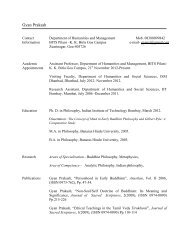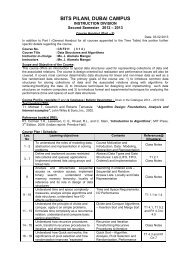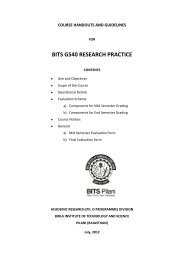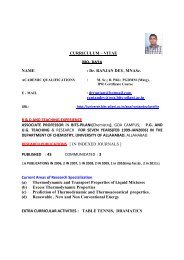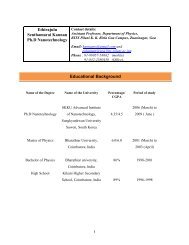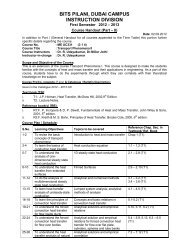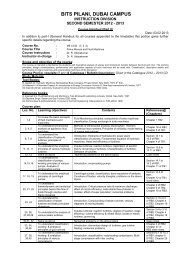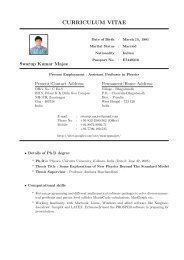BJT Internal Capacitances and High Frequency Model - BITS Pilani
BJT Internal Capacitances and High Frequency Model - BITS Pilani
BJT Internal Capacitances and High Frequency Model - BITS Pilani
Create successful ePaper yourself
Turn your PDF publications into a flip-book with our unique Google optimized e-Paper software.
<strong>BITS</strong> <strong>Pilani</strong><br />
presentation<br />
<strong>BITS</strong> <strong>Pilani</strong><br />
Dubai Campus<br />
Dr Jagadish Nayak
<strong>BITS</strong> <strong>Pilani</strong><br />
Dubai Campus<br />
The <strong>BJT</strong> <strong>Internal</strong> <strong>Capacitances</strong> <strong>and</strong><br />
<strong>High</strong> <strong>Frequency</strong> <strong>Model</strong>
<strong>BJT</strong> <strong>Internal</strong> <strong>Capacitances</strong><br />
۞Transistor exhibit charge storage phenomenon that limit the<br />
speed <strong>and</strong> frequency of their operation<br />
۞These charge effects are accounted by adding capacitances<br />
to the hybrid π model.<br />
Base charging or diffusion capacitance C de<br />
۞When the transistor is operating in active or Saturation region<br />
mode, minority carrier charge is stored in the base region.<br />
۞When an npn transistor is operating in active mode, this<br />
charge Q n ia represented by<br />
Q<br />
n<br />
2<br />
W<br />
2D<br />
n<br />
i<br />
C<br />
Where<br />
W<br />
Basewidth<br />
D<br />
n<br />
Eletron Diffusivityin Base<br />
<strong>BITS</strong> <strong>Pilani</strong>, Dubai Campus
<strong>BJT</strong> <strong>Internal</strong> <strong>Capacitances</strong><br />
We can write<br />
Q<br />
F<br />
n<br />
is<br />
2<br />
W<br />
FiC<br />
Where<br />
F<br />
2Dn<br />
called as Forward base<br />
transient<br />
time<br />
Which is the average time a charge carrier (electron) spends in<br />
crossing the base (10ps to 100ps)<br />
۞For the small signals we can define the small signal diffusion<br />
capacitance C de ,<br />
C<br />
de<br />
dQ<br />
dv<br />
n<br />
BE<br />
F<br />
di<br />
dv<br />
C<br />
BE<br />
F<br />
g<br />
m<br />
F<br />
I<br />
V<br />
C<br />
T<br />
<strong>BITS</strong> <strong>Pilani</strong>, Dubai Campus
<strong>BJT</strong> <strong>Internal</strong> <strong>Capacitances</strong><br />
The Base Emitter Junction Capacitance:<br />
(depletion layer capacitance)<br />
Value of C je at zero<br />
voltage<br />
Approximate value<br />
of C je =2 C je0<br />
EBJ Built in voltage<br />
(0.9)<br />
C<br />
je<br />
1<br />
C<br />
je0<br />
V<br />
V<br />
BE<br />
0e<br />
m<br />
Grading coefficient of<br />
EBJ (0.5)<br />
<strong>BITS</strong> <strong>Pilani</strong>, Dubai Campus
<strong>BJT</strong> <strong>Internal</strong> <strong>Capacitances</strong><br />
The Collector-Base Junction capacitance:<br />
In active mode collector base junction is reverse biased <strong>and</strong> its<br />
depletion capacitance<br />
CBJ Built in voltage<br />
(0.75V)<br />
C<br />
1<br />
C<br />
V<br />
V<br />
0<br />
CB<br />
0c<br />
m<br />
Value of C µ at zero<br />
voltage<br />
Grading coefficient of<br />
EBJ (0.2 to 0.5)<br />
<strong>BITS</strong> <strong>Pilani</strong>, Dubai Campus
<strong>High</strong> frequency Hybrid-π<br />
model<br />
Emitter base capacitance<br />
(C de +C je )pfarads<br />
B<br />
Collector base<br />
capacitance<br />
<strong>Model</strong> resistance of<br />
silicon material of<br />
the base region ,<br />
between base B <strong>and</strong><br />
a fictitious internal<br />
or intrinsic, base<br />
terminal B’ (right<br />
under the emitter<br />
region)<br />
<strong>BITS</strong> <strong>Pilani</strong>, Dubai Campus
<strong>High</strong> frequency Hybrid-π<br />
model<br />
Emitter base capacitance<br />
(C de +C je )pfarads<br />
B<br />
B’<br />
Collector base<br />
capacitance<br />
(Few tens of Ωs)<br />
Since r x
Cut off frequency<br />
۞Value of Cπ is not given in the data sheet rather behavior<br />
of β (or hfe) versus frequency is normally given.<br />
۞To find Cπ <strong>and</strong> Cµ , derive an expression for hfe. i.e short<br />
circuit current gain as a function of frequency interms of<br />
hybrid π components.<br />
Consider following model<br />
<strong>BITS</strong> <strong>Pilani</strong>, Dubai Campus
Cut off frequency<br />
Collector is shorted to the emitter at Junction C<br />
E<br />
<strong>BITS</strong> <strong>Pilani</strong>, Dubai Campus
Cut off frequency<br />
E<br />
I<br />
c<br />
I b sC µ V π I c =(g m -sC µ )V π<br />
V<br />
sC V<br />
g<br />
m<br />
V<br />
I<br />
c<br />
g<br />
m<br />
V<br />
sC V<br />
g<br />
m<br />
sC<br />
<strong>BITS</strong> <strong>Pilani</strong>, Dubai Campus
Cut off frequency<br />
I b sC µ V π I c =(g m -sC µ )V π<br />
V π = I b x [Impedence sum<br />
between B’ <strong>and</strong> E]<br />
E<br />
V<br />
1<br />
r<br />
I<br />
I<br />
b<br />
b<br />
[ r<br />
sC sC<br />
||<br />
C<br />
||<br />
C<br />
]<br />
<strong>BITS</strong> <strong>Pilani</strong>, Dubai Campus
Cut off frequency<br />
The model is valid for g m >>>wC µ , we can neglect wC µ in the numerator<br />
h<br />
fe<br />
h<br />
fe<br />
( or<br />
I<br />
c<br />
gmr<br />
0<br />
( or )<br />
I 1 s(<br />
C C ) r 1 s(<br />
C<br />
Low frequency value of β<br />
b<br />
)<br />
I<br />
I<br />
c<br />
b<br />
1<br />
r<br />
g<br />
m<br />
s(<br />
C<br />
sC<br />
w<br />
C<br />
)<br />
( C<br />
1<br />
C<br />
C<br />
) r<br />
) r<br />
This has a single pole response with<br />
3dB frequency at w=w β<br />
Where<br />
<strong>BITS</strong> <strong>Pilani</strong>, Dubai Campus
Cut off frequency<br />
We can observe from the above slope that frequency at which<br />
|h fe | drops to unity is called as unity gain b<strong>and</strong>width w T <strong>and</strong> is<br />
given by w T =β 0 w β<br />
w<br />
T<br />
gm<br />
gm<br />
; fT<br />
( C C ) 2 ( C C<br />
)<br />
f T is some times specified in the<br />
datashet or given as a function of<br />
I c <strong>and</strong> V CE<br />
<strong>BITS</strong> <strong>Pilani</strong>, Dubai Campus




